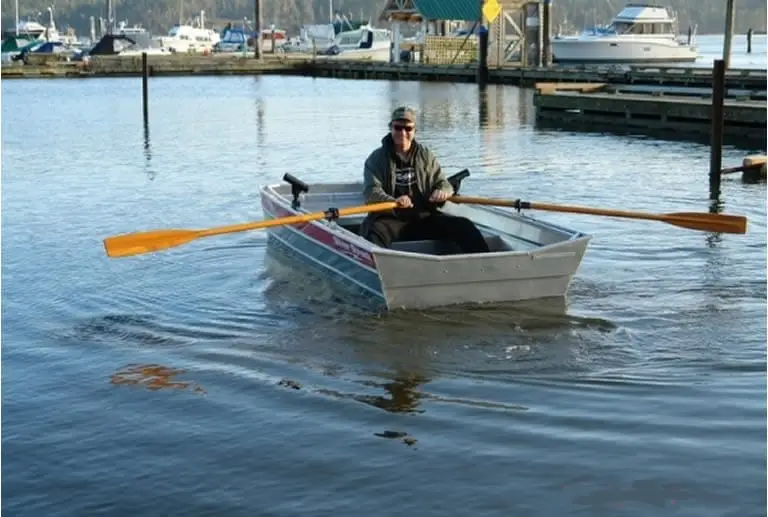Most Jon boats are not manufactured with oar locks. So, when it comes to a Jon boat can it be rowed?
Contents
It is possible to row a Jon boat & sometimes oars can come in handy
You can row a Jon boat.
Some Jon boats may need to be modified by adding oarlocks before rowing can be achieved.
Certain conditions will affect your ability to row a Jon boat effectively.
Rowing styles, such as ‘canoe style’ with a single paddle or double-paddle, and oar rowing have different levels of practicality.
A Jon boat is a flat-bottom boat sometimes made from hardwood, plywood or fiberglass but more commonly made from aluminum.
It is designed perfectly for shallow, calm waters, as the practically flat hull enables the boat to ride on the surface of the water exceptionally smoothly when it is powered by a motor.
Its shallow draft also means it can easily traverse extremely shallow waterways where many other boats could not access.
Although rowing a Jon boat may be beneficial to those who want to enjoy a quiet family day on the river or lake it is most beneficial for fishermen and especially for duck hunters.
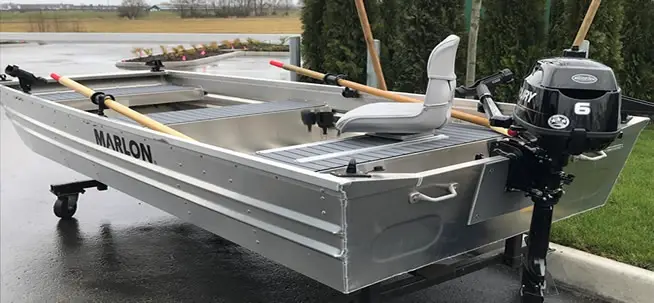
As long as you use the correct oars and oarlocks.
A Jon boat is the preferred vessel for fishermen and duck hunters because it can easily access shallow waters thus making it perfect for use in shallow rivers and lakes.
A Jon boat can also easily gain access to shallow river banks.
Obviously in such circumstances using a motor is impractical as the noise could alert the prey to the presence of hunters.
However, this is not the only time when using an engine is inadvisable.
Because a Jon boat is designed to access shallow waterways this means you may find yourself in a situation where using an outboard motor is just impractical.
In fact, you will likely find yourself in situations where is actually impossible to use your outboard motor. This will usually be due to the extremely shallow water and very close proximity of the river bed and rocky obstacles that may lie there.
Therefore a Jon boat allows fishermen and hunters to access very shallow water and to access areas with stealth.
So obviously the best solution in these circumstances would be to use some form of manual propulsion, such as rowing.
But is a Jon boat capable of being rowed?
The simple answer is “yes”. Though it may not be as easy a task to undertake as it would be with other boat types.
When a Jon boat is powered by a gas motor the boat performs very well under calm conditions but under oar-power the same boat may not be as straight forward to maneuver as you might imagine.
Why it’s sometimes a good idea to be able to row a Jon boat
Why should you even bother rowing a Jon boat when they are built to take motors?
As you have already seen there will be circumstances in which using a motor is not practical, such as when hunting or in very shallow waters.
However, this is not the only reason for rowing a Jon boat.
Rowing a Jon boat might be the only form of propulsion allowed in certain waterways due to local regulations.
These regulations may be in place to protect the habitat from the noise pollution that motors often create or from potential environmental hazards associated with motorized watercraft, for example.
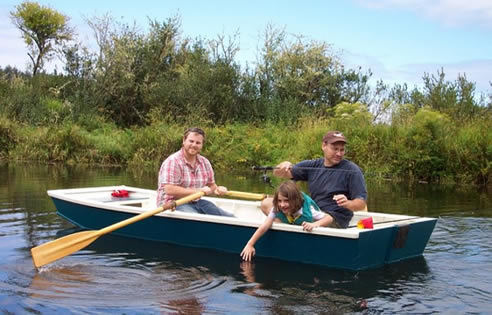
Attempting to row a Jon boat using oars can be quite a daunting task at first but it’s a very useful skill to acquire.
Some say it’s a bit of a lost art but it is actually a skill than anyone can learn.
There are rowing techniques you can easily learn that will help you get the best from any boat.
‘Feathering the oars’ or learning how to ‘ship the oars’ are just some of the basic terms associated with rowing.
There are often different terms associated with different sports or boat usage.
So, in this article we’ll cover the basics of rowing a Jon boat and try not get to get too hung up on specific rowing terms.
Rowing can provide sufficient exercise for all age groups and by the very nature of individual rowing, it can also be very calming and relaxing.
For small Jon boats however, rowing can be fun and ideal for leisurely trips but ultimately, rowing is usually used as a manual safety mechanism if a motor should ever fail.
Concerns when rowing a Jon boat
You may encounter problems when rowing a Jon boat in waterways that contain motorized traffic.
Powered boats may raise safety concerns to manually powered craft and in places where rowing boats are the preferred means of propulsion.
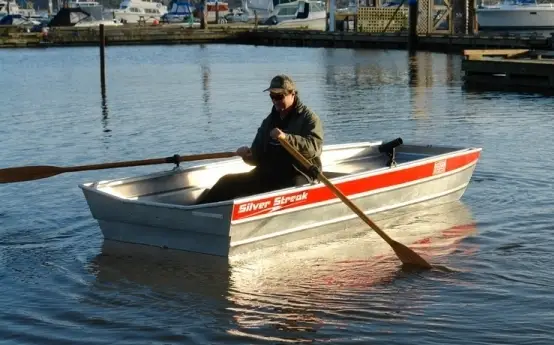
Check the local regulations from state to state and from waterway to waterway.
This way you won’t be at risk from the dangers of someone speeding past you while you’re happily rowing along on your Jon boat.
Other concerns are connected to your health and fitness levels.
While rowing is an excellent form of exercise, it is wise to seek medical advice before embarking on any distance rowing.
This is especially important if you plant to row a Jon boat which can be difficult to row compared to a row boat.
The physical nature of having to manually row a boat can be very arduous and personal endurance will be the testing factor in rowing ability.
Rowing a Jon boat can be physically demanding.
Not only that, but other influences such as the size of the boat, the load capacity and the conditions of the waterway can also take their toll on even the fittest rower.
Advantages of rowing a Jon boat
* Low impact cardio exercise
* Burns fat while building muscle
* Increases endurance
* Relieves stress
* Exercises joints and encourages greater flexibility
Disadvantages of rowing a Jon boat
* Impractical for those with back and spine problems
* Increased risk of sinking when rowing during foul weather conditions
* Slow getting from A to B
* Arduous and physically demanding
How to row a Jon boat efficiently
Here is a simple technique for rowing your Jon boat.
- Sit on the bench between the oarlocks facing the stern, along the centerline of the boat.
- Secure feet against solid structure or flat on the deck, knees bent.
- Hold one oar in each hand, thumb over the end of the oar.
- Straighten your arms and bend forward from the waist – keep the oars just out of the water behind you (Catch position).
- Enter the oars into the water and pull the oar handles towards your chest while straightening your back at the same time (Drive position).
- At the end of the drive position, with the oars still in the water, your back should be straight with arms bent (release position).
- Lift the oars from the water, turning them slightly to feather the oars (leveling the oars parallel to the water to reduce wind resistance).
- Turn the oars perpendicular to the water and return to the catch position.
Note:
Your back should be upright when carrying out the release position to avoid lower back strain and avoid long term injury.
It is more efficient to keep the oars just below the surface during the drive.
So avoid dipping the oars too deep into the water.
You will be facing the rear of the boat while travelling forward, be aware of your direction of travel and look around frequently to stay on course and to avoid obstacles.
How to turn when rowing a Jon boat
There are several techniques you can call upon to turn your boat or change course while rowing.
- Whilst rowing with both oars, simply stop rowing with one oar and continue with the other to move the bow left or right. Continue with that oar until the new heading is set and then return to two oar rowing.
- For a sharper turn while rowing, place one oar into the water while continuing to row with the other until the new heading is set.
- If you are at a standstill then both oars can be used in opposite strokes (one forward stroke while the other is a backwards stroke) to pivot the boat about its center.
- On a Jon boat a paddle may be used to maneuver at low speeds and change direction when used at the bow, stern or at either side of the boat (more on paddling below).
Important factors to consider before rowing a Jon boat
Physical ability – Rowing a boat can be very physically demanding so be sure to row at a pace within your level of fitness.
Proper technique: Rowing with poor technique is inefficient and will actually increase the physical demands on you.
Size and Weight capacity of boat – The ideal boat size for individual rowing is around 12 – 17 feet but the rowing efficiency will depend on the amount of weight within the boat.
The more water displaced by the boat, the more difficult it becomes to row.
Weather and Waterway conditions – A calm flat lake will be easier to row a boat across than one in choppy conditions. Though be aware that Jon boats are not designed to be used in choppy conditions. Rowing into headwinds is obviously more difficult than rowing with a tail wind.
Length and type of oars – Oar types and length are important to various boat types and sizes. Personal preference in oar length is a factor however, oar length can be accurately calculated to suit any rowing boat.
The size of oars you need for a Jon boat depend on the boat size
Having the correct size of oars improves personal comfort and general efficiency when rowing.
Oar length is calculated generally by the size of the boat or more precisely, the width of the boat, from oarlock to oarlock.
The distance between oarlocks is halved and this becomes part of a ratio working out at roughly 1/3 oar inboard and 2/3 oar outboard.
Shaw & Tenney of Maine created an ideal formula back in 1858 for oar leverage with a ratio of 7:25 that is to say 7/25 the length of the oar is inboard while 18/25 is outboard.
That sounds a little complicated but again, equates to roughly 1/3 inboard and 2/3 outboard.
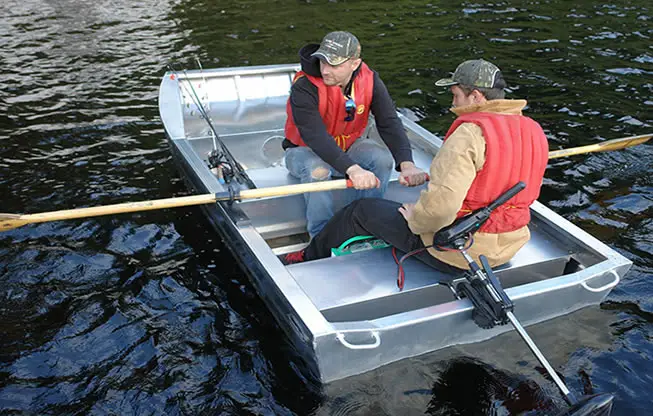
Allowing one to two inches between oars, this ratio is suitable for all types of boats.
If an overhand rowing position is preferred then 6 inches should be added to the length of the oars.
If the oars tend to pop out of the oarlocks then the oars are too short and the correct length should be fitted, considering the 1/3 – 2/3 ratio.
Rule-of-thumb quick way to determine oar length
- Divide the boat length by 2 and add 1 = oar length
- Gunwale (gunnel) to centerline = 1/3 oar length
Accurate way to determine correct oar length
- Measure the distance between oarlock to oarlock, called the span.
- Divide span by 2 then add 2 to this number to give a figure called ‘inboard loom length’.
- Multiply the loom length by 25.
- Divide the result by 7 and this is the correct oar length in inches.
Take the example for a 4’ wide boat:
- 4′ span = 48″
- 48/2 = 24 + 2 = 26 (inboard loom length)
- 26 x 25 = 650
- 650 / 7 = 92.8″ or 7′ 7″ (rounded down – use 7′ 6″ oars)
Chart 1. Guide to oar length against boat width (the span)
WIDTH OAR LENGTH
40” – 44” 6’6” – 7’
44” – 48” 7’ – 7’-6”
48” – 52” 7’6” – 8’
52” – 56” 8’ – 8’6”
56” – 60” 8’6” – 9’
60” – 64” 9’ – 9’6”
64” – 68” 9’6” – 10’
How to install oars on a Jon boat (video)
Some Jon boats require some modification for them to function properly as rowing boats.
For oars to be used, oarlocks must be installed at convenient positions.
On a Jon boat the fixed seating position will determine the location of the oarlocks.
The oarlocks can be either clamped into position or permanently fixed to the hull.
Rowing vs padding – how to choose the better option
Occasionally people mistakenly use the terms ‘rowing’ and ‘paddling’ interchangeably, likewise many mistakenly refer to oars as paddles and vice versa.
Rowing refers to the act of propelling a boat with the aid of oars.
The oars are mechanically connected to the boat while paddling requires a single, hand-held paddle with no mechanical connection to the boat whatsoever.
While oars and paddles may look similar, they are used in different ways to propel the boat.
An oar has one blade, the part that goes into the water and is supported by a fulcrum, the oarlock, while a paddle usually has two blades and one hand of the paddler acts as the fulcrum.
A paddler will also be facing the direction of travel while a rower will be facing rearward.
Paddles are most commonly seen being used on canoes and kayaks.
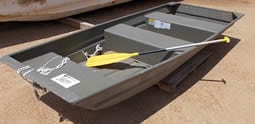
The benefits of paddling a Jon boat
Propelling a Jon boat using a paddle (the right type of paddle) may be necessary when other forms of propulsion are not suitable, this might be when:
- Oars become too cumbersome in certain environments.
- Rowing may not be feasible because oarlocks are not be fitted.
- Stealth is required.
- Agility is required.
A Jon boat is too wide to paddle with a double-bladed paddle, so the use of a single blade bladed paddle is sufficient for general use.
A Jon boat can be paddled from the bow or stern position or from either side of the boat.
Paddling is most suitable when travelling at slow speeds or when agility is required and in very shallow waters where an engine can’t be used.
It is not practical to attempt to paddle a Jon boat at speed or over long distance because the weight of the vessel and its contents make paddling very inefficient and very tiring.
The physical demands required of the paddler to propel the Jon boat at speed or over great distance is also impractical.
How to paddle a Jon boat
- To achieve good leverage through the paddle, sit within the boat or kneel on the deck. Paddling while standing is inadvisable, leads to instability and not particularly comfortable (tough there are ways to stabilize a Jon boat).
- If you are paddling on the right side of the boat, grasp the paddle with the right hand roughly half way up the paddle and place your other hand on the handle. Reverse hands when paddling on the left side of the boat.
- The catch, or start of the paddle stroke, starts with twisting your torso so that your shoulder is projected forward. From this position place the paddle into the water so that the whole blade is immersed. The paddle should be vertical at this point.
- The power stroke is taken when you straighten your torso whilst moving your arms rearwards. The paddle should be vertical during the full range of movement, ending when the paddle is at your hip.
- Return to the catch position.
How to paddle a Jon boat (video)
See how paddling a Jon boat is performed in this video.
Summing it up
In most instances it’s perfectly feasible to row any boat.
So you can row a Jon boat.
However, the manual effort required to row a Jon boat will depend on a variety of factors such as the size of the boat, its weight capacity and length of oars, to name a few.
Poor weather conditions and the environment of the waterways as well as your physical condition will also affect your ability to row a Jon boat effectively.
Rowing styles, such as ‘canoe style’ with a single paddle or a double-paddle, and oar rowing styles, have different levels of practicality.
The rowing style you should use often depends on the water conditions and depth of the waterway.
Some Jon boats may need to be modified before rowing can be achieved like adding oarlocks, braces that fix to the boat to retain the oars.

